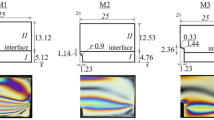Summary
Steady thermal stresses in a plate made of a functionally gradient material (FGM) are analyzed theoretically and calculated numerically. An FGM plate composed of PSZ and Ti-6Al-4V is examined, and the temperature dependence of the material properties is considered. A local safety factor is used for evaluation of the FGM's strength. It is assumed that top and bottom surfaces of the plate are heated and kept at constant thermal boundary conditions. The pairs of the surface temperatures, for which the minimum local safety factor can be of more than one, are obtained as available temperature regions. The temperature dependence of the material properties diminishes, available temperature region as compared with that for an FGM plate without it. The available temperature region of the FGM plate is wider than that of the two-layered plate, especially for the surface temperatures which are high at the ceramic surface and low at the metal side. The influence of different mechanical boundary conditions is examined, and available temperature regions are found to be different, depending on the mechanical boundary conditions. The influence of the intermediate composition on the thermal stress reduction is also investigated in detail for the surface temperatures which are kept at 1300 K at the ceramic surface and 300K at the metal side. Appropriate intermediate composition of the FGM plate can yield the local safety factor of one or more for the four mechanical boundary conditions at once. For the two-layered plate there does not exist, however, any appropriate pair of metal and ceramic thicknesses which would yield the local safety factor of one or more for the four mechanical boundary conditions at once. The influence of the intermediate composition on the maximization of the minimum stress ratio depends on the mechanical boundary conditions. Finally, the optimal FGM plates are determined.
Similar content being viewed by others
References
Hasselman, D. P. H.; Youngblood, G. E.: Enhanced thermal stress resistance of structural ceramics with thermal conductivity gradient. J. Am. Ceram. Soc. 61 (1978) 49–52
Koizumi, M.: The concept of FGM. In: Holt, J. B.; Koizumi, M.; Hirai, T.; Munir, Z. A. (eds.), Ceramic Transactions, Vol. 34, Functionally Gradient Materials, pp. 3–10. Westville: American Ceramic Society 1993
Ishikawa, T.: Thermal deformation and thermal stress of FGM plate under streadily gradient temperature field. In: Yamanouchi, M.; Koizumi, M.; Hirai, T.; Shiota, I. (eds.), Proc. of the First Int. Sym. on Functionally Gradient Materials, pp. 11–16, Tokyo: Functionally Gradient Materials Forum 1990
Noda, N.; Tsuji, T.: Steady thermal stresses in a plate of functionally gradient material. In: Yamanouchi, M.; Koizumi, M.; Hirai, T., Shiota, I. (eds.), Proc. of the First Int. Sym. on Functionally Gradient Materials, pp. 339–344. Tokyo: Functionally Gradient Material Forum 1990
Watanabe, R.; Kawasaki, A.; Murahashi, N.: Fabrication of a thermal-stress relief type of functionally gradient material in Molybdenum/Zirconia system. J. of the Assoc. of Mat. Eng. of Resources, 1 (1988) 36
Obata, Y.; Noda, N.; Tsuji T.: Steady thermal stresses in a functionally gradient material plate (Influence of Mechanical Boundary Conditions) (in Japanese). Trans. Jpn. Soc. Mech. Eng. 58-A (1992) 1689–1695
Obata, Y.; Noda, N.: Steady thermal stresses in a hollow circular cylinder and a hollow sphere of a functionally gradient material. J. Thermal Stresses, 17 (1994) 471–487
Obata, Y.; Noda, N.: Transient thermal stresses in a plate of functionally gradient material. In: Holt, J. B.; Koizumi, M.; Hirai, T.; Munir, Z. A. (eds), Ceramic Transactions, Vol. 34, Functionally Gradient Materials, pp. 403–410, Westville, American Ceramic Society 1993
Kingery, W. D.; Bowen, H. K.; Uhlmann, D. R.: Introduction to ceramics. New York: John Wiley & Sons 1976
R. Kondo et al.: Takou Zairyou (Porous Materials) (in Japanese) Tokyo: Gihoudo 1986
Author information
Authors and Affiliations
Rights and permissions
About this article
Cite this article
Obata, Y., Noda, N. Optimum material design for functionally gradient material plate. Arch. Appl. Mech. 66, 581–589 (1996). https://doi.org/10.1007/BF00808146
Received:
Accepted:
Issue Date:
DOI: https://doi.org/10.1007/BF00808146




